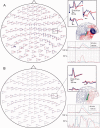Effects of DBS on auditory and somatosensory processing in Parkinson's disease
- PMID: 20645306
- PMCID: PMC6870287
- DOI: 10.1002/hbm.21096
Effects of DBS on auditory and somatosensory processing in Parkinson's disease
Abstract
Motor symptoms of Parkinson's disease (PD) can be relieved by deep brain stimulation (DBS). The mechanism of action of DBS is largely unclear. Magnetoencephalography (MEG) studies on DBS patients have been unfeasible because of strong magnetic artifacts. An artifact suppression method known as spatiotemporal signal space separation (tSSS) has mainly overcome these difficulties. We wanted to clarify whether tSSS enables noninvasive measurement of the modulation of cortical activity caused by DBS. We have studied auditory and somatosensory-evoked fields (AEFs and SEFs) of advanced PD patients with bilateral subthalamic nucleus (STN) DBS using MEG. AEFs were elicited by 1-kHz tones and SEFs by electrical pulses to the median nerve with DBS on and off. Data could be successfully acquired and analyzed from 12 out of 16 measured patients. The motor symptoms were significantly relieved by DBS, which clearly enhanced the ipsilateral auditory N100m responses in the right hemisphere. Contralateral N100m responses and somatosensory P60m responses also had a tendency to increase when bilateral DBS was on. MEG with tSSS offers a novel and powerful tool to investigate DBS modulation of the evoked cortical activity in PD with high temporal and spatial resolution. The results suggest that STN-DBS modulates auditory processing in advanced PD. Hum Brain Mapp, 2011. © 2010 Wiley-Liss, Inc.
Copyright © 2010 Wiley-Liss, Inc.
Figures




Similar articles
-
Differentiated effects of deep brain stimulation and medication on somatosensory processing in Parkinson's disease.Clin Neurophysiol. 2017 Jul;128(7):1327-1336. doi: 10.1016/j.clinph.2017.04.014. Epub 2017 May 2. Clin Neurophysiol. 2017. PMID: 28570866
-
Quantitatively validating the efficacy of artifact suppression techniques to study the cortical consequences of deep brain stimulation with magnetoencephalography.Neuroimage. 2019 Oct 1;199:366-374. doi: 10.1016/j.neuroimage.2019.05.080. Epub 2019 May 31. Neuroimage. 2019. PMID: 31154045 Free PMC article.
-
Deep brain stimulation of subthalamic nucleus modulates cortical auditory processing in advanced Parkinson's Disease.PLoS One. 2022 Feb 24;17(2):e0264333. doi: 10.1371/journal.pone.0264333. eCollection 2022. PLoS One. 2022. PMID: 35202426 Free PMC article. Clinical Trial.
-
Congress of Neurological Surgeons Systematic Review and Evidence-Based Guideline on Subthalamic Nucleus and Globus Pallidus Internus Deep Brain Stimulation for the Treatment of Patients With Parkinson's Disease: Executive Summary.Neurosurgery. 2018 Jun 1;82(6):753-756. doi: 10.1093/neuros/nyy037. Neurosurgery. 2018. PMID: 29538685 Free PMC article.
-
Evoked potentials generated by deep brain stimulation for Parkinson's disease.Brain Stimul. 2022 Sep-Oct;15(5):1040-1047. doi: 10.1016/j.brs.2022.07.048. Epub 2022 Jul 31. Brain Stimul. 2022. PMID: 35921959 Free PMC article. Review.
Cited by
-
Deep Brain Stimulation Does Not Modulate Auditory-Motor Integration of Speech in Parkinson's Disease.Front Neurol. 2020 Jul 10;11:655. doi: 10.3389/fneur.2020.00655. eCollection 2020. Front Neurol. 2020. PMID: 32754112 Free PMC article.
-
Cortical Signal Suppression (CSS) for Detection of Subcortical Activity Using MEG and EEG.Brain Topogr. 2019 Mar;32(2):215-228. doi: 10.1007/s10548-018-00694-5. Epub 2019 Jan 3. Brain Topogr. 2019. PMID: 30604048 Free PMC article.
-
Word onset tracking in neural responses of human basal ganglia nuclei.Brain Struct Funct. 2025 Jun 25;230(6):105. doi: 10.1007/s00429-025-02968-8. Brain Struct Funct. 2025. PMID: 40560240 Free PMC article.
-
Utility of temporally-extended signal space separation algorithm for magnetic noise from vagal nerve stimulators.Clin Neurophysiol. 2013 Jul;124(7):1277-82. doi: 10.1016/j.clinph.2012.03.082. Epub 2012 Jun 23. Clin Neurophysiol. 2013. PMID: 22727713 Free PMC article.
-
Analysis of simultaneous MEG and intracranial LFP recordings during Deep Brain Stimulation: a protocol and experimental validation.J Neurosci Methods. 2016 Mar 1;261:29-46. doi: 10.1016/j.jneumeth.2015.11.029. Epub 2015 Dec 14. J Neurosci Methods. 2016. PMID: 26698227 Free PMC article.
References
-
- Deuschl G, Schade‐Brittinger C, Krack P, Volkmann J, Schafer H, Botzel K, Daniels C, Deutschlander A, Dillmann U, Eisner W, Gruber D, Hamel W, Herzog J, Hilker R, Klebe S, Kloss M, Koy J, Krause M, Kupsch A, Lorenz D, Lorenzl S, Mehdorn HM, Moringlane JR, Oertel W, Pinsker MO, Reichmann H, Reuss A, Schneider GH, Schnitzler A, Steude U, Sturm V, Timmermann L, Tronnier V, Trottenberg T, Wojtecki L, Wolf E, Poewe W, Voges J; German Parkinson Study Group, Neurostimulation Section ( 2006): A randomized trial of deep‐brain stimulation for Parkinson's disease. N Engl J Med 355: 896–908. - PubMed
-
- Folstein MF, Folstein SE, McHugh PR ( 1975): Mini‐mental state: A practical method for grading the cognitive state of patients for the clinician. J Psychiatr Res 12: 189–198. - PubMed
Publication types
MeSH terms
LinkOut - more resources
Full Text Sources
Medical

